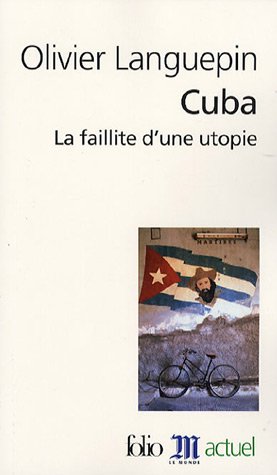libertés
Building a Home in Cuba, Without Bank Loans, Without Legal Supply Markets
Photo: Silvia Corbelle She gets up and has a little coffee. The concrete of the counter is still fresh. Magaly, her two sons and her husband live in a house under construction. They’ve spent seven years like this.
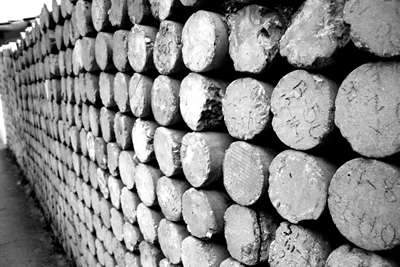
She gets up and has a little coffee. The concrete of the counter is still fresh. Magaly, her two sons and her husband live in a house under construction. They’ve spent seven years like this. Little by little raising the walls and installing some pipes. Every day that goes by they get closer to the end of the job, but they also live through another day of anxiety and risks to get the materials. Today they need stone dust and washed sand. They get their money together before heading out to the state supply center, inviting me to accompany them. We arrive at the central warehouse, but at the door an employee delivers the bad news. They haven’t stocked up, we’ll have to wait until next week.
We then dive into the world of resellers of cement fillers. Finding them is easy; haggling, impossible. The area around the Cristina railway workshop is the best supplied hardware black market in the whole country. You just have to walk through the doorways and gates for voices to call out asking, « What are you looking for? » We’re cautious, it’s not recommended to go with the first offer. Swindles are everywhere. One man, with a little table where he’s fixing lighters, looks at us and whispers, « I have everything for construction. » In a conjurer’s gesture he passes us a much-handled sheet that contains a list of prices: gravel and sand, 1.50 convertible pesos (CUC)* per sack; Jaimanita exterior stone, 7.00 CUC per square meter; and granite tiles, 10.00 CUC, also per square meter. « If you buy a large quantity transport is included, » he points out, while dismantling a lighter with an Italian flag drawn on the plastic.
My friends do the accounting. Acquiring surfacing for the entire floor would cost their combined wages for 20 months. The costs of the bathroom fixtures are enough to elicit a little scream from Magaly, but it’s barely audible, covered by the noise of the road. They decide to prioritize. Today they’ll take only some blocks, several sacks of sand, and two wooden doors. The vendor adds it up and rounds it off to everything Magaly and her husband earn for half a year’s work. « It will always be a cheaper option than the legal stores, » she says out loud to console herself.
Night falls and everyone’s fingers are covered with a gray layer of cement and dust. The children go to bed in the only room that has a roof. The counter has hardened and the dirty dishes are left on its rough surface because there are still no pipes to deliver the water to wash them. Tomorrow they’ll have to go out and get steel and some electrical switches. One construction day less. Twenty-four hours closer to having their house finished.
*Translator’s note: One Cuban convertible peso (known as a CUC and convertible only in Cuba), is worth roughly one US dollar (before exchange fees). The average monthly wage in Cuba is less than $20 US, and is generally paid in Cuban pesos (CUP); 24 CUP = 1 CUC. Many everyday items, and most « specialty » items are only sold for CUCs, including in State stores.
My English language blog has moved to a new site: PLEASE CLICK HERE.
My blog in other languages can be accessed HERE.
Read More:
Building a Home in Cuba, Without Bank Loans, Without Legal Supply Markets
libertés
After 40 Years of Working, Keeping Body and Soul Together Selling Plastic Bags
Selling ‘jabitas’ (plastic bags) in front of an agricultural market in Havana. (Luz Escobar) 14ymedio, Yoani Sanchez, Havana, 28 August 2014 – « I need some dark glasses, » Veronica told me one day when I ran into her on the street. Almost seventy, the lady underwent cataract surgery some months ago and now must « take care of my eyes, » as she explained to me. She works in the sun selling jabitas (plastic bags) to the customers of the farmers market on Tulipan Street.
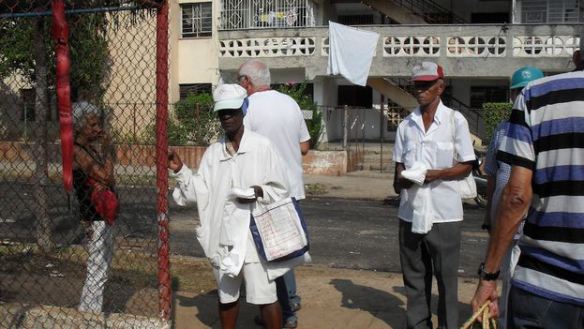

Selling ‘jabitas’ (plastic bags) in front of an agricultural market in Havana. (Luz Escobar)
14ymedio, Yoani Sanchez, Havana, 28 August 2014 – « I need some dark glasses, » Veronica told me one day when I ran into her on the street. Almost seventy, the lady underwent cataract surgery some months ago and now must « take care of my eyes, » as she explained to me. She works in the sun selling jabitas (plastic bags) to the customers of the farmers market on Tulipan Street. The harsh midday glare is hard on her eyesight, but that’s not the worst of her problems. « We have an alarm system to know when the police are coming, although sometimes they’re in plainclothes and catch us by surprise. » Last month she paid a 1,500 Cuban peso fine (roughly $60 US) for engaging in illegal sales, and this week she received a warning letter for recidivism for the same offense.
If you read articles like Randy Alonso’s about the absence of bags in the hard currency stores, you might come to believe this resource is being diverted into the hands of unscrupulous traders. However, it’s enough to simply know Veronica to understand that her business is one more of misery than of profit. For the four decades she worked as a cleaning assistant in a school, the lady now receives a pension that doesn’t exceed ten dollars a month. Without the resale of the plastic bags, she would have to beg, but she asserts that she « would die before asking for money in the streets. » She is not to blame, rather she is a victim of the circumstances that have pushed her into an illegal activity to survive.
Having to carry purchases in one’s hands in the absence of bags is something that annoys any buyer. But realizing that Randy Alonzo, one of the great spokesmen of the current system, doesn’t know the human dramas that lead to the diversion of plastic bags, is even more irritating. It’s not about callous people who are dedicated to enriching themselves through the fruits of State embezzlement, but rather citizens whose economic poverty leads them to resell whatever product comes into their hands. Right now Veronica is outside some business, wearing the old dark glasses they gave her, muttering « I have jabitas, I have jabitas, one peso each. »
More:
After 40 Years of Working, Keeping Body and Soul Together Selling Plastic Bags
libertés
Cuba’s Official Press: Triumphalism, Blacklisting and Censorship
News kiosk (Luz Escobar) 14YMEDIO, Havana, Yoani Sanchez, 22 August 2014 – The phone rings and it’s a friend who works for a government publication. She’s content because she’s published an article that attacks bureaucracy and corruption. The young woman finished college two years ago and has been working in a digital medium that deals with cultural and social issues. She has the illusions of a recent graduate, and she believes she can do objective journalism, close to reality, and help to improve her country
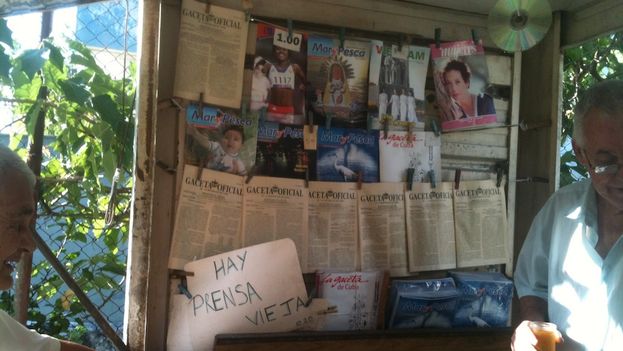
14YMEDIO, Havana, Yoani Sanchez, 22 August 2014 – The phone rings and it’s a friend who works for a government publication. She’s content because she’s published an article that attacks bureaucracy and corruption. The young woman finished college two years ago and has been working in a digital medium that deals with cultural and social issues. She has the illusions of a recent graduate, and she believes she can do objective journalism, close to reality, and help to improve her country.
My friend has had some luck, because she exercises this profession at a time when the national media is trying to more closely reflect the problems of our society. The official journalist exists in a timid Glasnost, 25 years after a similar process in the Soviet Union. If that attempt at « information transparency » was promoted through Perestroika, on the Island it’s been pushed by the Sixth Communist Party Congress Guidelines. In this way, a more objective and less triumphalist press is pushed–from above. The same power that helped create laudatory newspapers, now urges a shift from applause to criticism. But it’s not easy.
The original sin of the official press is not the press, but propaganda. It emerged to sustain the ideological political-economic model and it can’t shed that genesis. The first steps in the creation of the current national media always includes an act of faith in the Revolution, It is also funded entirely by the Government, which further affects its editorial line. It’s worth noting that the official media is not profitable, that is, it doesn’t generate income or even support its print runs or transmissions. Hence, it operates with subsidies taken from the national coffers. All Cubans sustain the newspapers Granma and Juventude Rebelde (Rebel Youth), the Cubavision channel or Radio Reloj (Clock Radio)… whether we like it or not.
Moreover, the official press is structured so that nothing can escape to the front page of the newspapers or to the TV and radio microphones that hasn’t been previously inspected. They are characterized by their strict elements of supervision.
Architecture of Control
My friend is facing at least four strong mechanisms of censorship she must deal with every day and which she rarely manages to successfully evade. Cuba has come to have one of the most sophisticated methods of monitoring information anywhere in the world. At the highest point of this architecture of control is the Department of Revolutionary Orientation (DOR), an entity belonging to the Central Committee of the Cuban Communist Party. A group of people–designated for their ideological loyalty–analyze all the journalistic content published in the country, and, from these observations, follows certain topics and authors.
The DOR is also responsible for drawing up the so-called « thematic plan » in which it programs the issues the Cuban press will address in a specified time period, and with what intensity it will do so. Right now, for example, just looking at national television we can see that there is a marked intention to speak optimistically about the Port of Mariel, foreign tourism and agricultural production.
Not only political issues or international relations pass through that filter. Control is also exerted over the music broadcast on radio stations and the music videos, soap operas, and science programs aired on television. The so-called black lists of singers or banned authors in the national media come entirely from the DOR. This so painful and prolonged phenomenon has been losing ground in recent years, more from social pressures than because of a sincere process of self-criticism among the censors.
The heads of the press organs must meet regularly with « the comrades from the DOR » to ensure that the plan of topics decided from above is carried out. But the influence of this entity does not end there. The directors of the newspapers and the heads of specific pages or specialized pages will only be appointed with the consent of this department, which in many cases is the person who placed them in their positions. This extends to the national and provincial organs, the municipal radio stations and the specialized magazines. The Journalism School at the University of Havana also receives direct attention from the Department of Revolutionary Orientation, which controls its curriculum and involves itself in the process of choosing new students. Nothing moves in the Cuban press without this watchtower of censorship knowing about it.
Promote the positive results
Another control mechanism that grips the official press is that imposed by the institutions and ministries. From the departments overseeing these entities, journalists are encouraged to promote the sectors they cover. Only with the authorization of these State organs, can the reporters access offices, files, review meetings, press conferences, the interior of a factory, or a cultural center or school.
This second control filter placed on institutions gives birth to a kind of journalism that has done a great deal of harm to Cuban society. One full of triumphalism, inflated figures, and « everything is perfect. » This pseudo-information has been so abused that popular humor is full of jokes about it. Like the one about when the news comes on and people put a bag under the TV to collect the food that appears in the reports, but that never show up in reality. This practice fosters opportunism, as well as making reporters think, « I’d better not get in trouble, if it’s good for me here. » There are sectors that are very attractive to cover, like tourism, because they include gifts, invitations, eating in hotel restaurants, and even all-expense-paid weekends at resorts.
Surveillance in the hallways
The third control mechanism makes people afraid to even say its name. The role of the Ministry of the Interior in every press organ. Every newspaper, radio station, TV channel or provincial newspaper has one or several people who are responsible for « seeing to » the security of the center. This department is responsible for investigating the extra-professional activities of every reporter, photographer or graphic designer. To spy on what they say in the hallways, supervise the questions they ask in interviews–particularly if it involves a foreigner–and whether they have contacts in the opposition or among independent journalists.
The more sophisticated control mechanism
If my friend makes it past those three control mechanism without deleting a line or one of her works being prohibited, she will still face the most efficient and sophisticated of all. It’s euphemistically called self-censorship and is nothing more than the result of pressure exercised over the communicator by the instruments of control and punishment.
Self-censorship acts as a psychological barrier and is expressed in the omissions that each journalist makes to stay on safe ground and not get too close to the allowed limit. However, the victim of self-censorship doesn’t always see it like this, rather she justifies her attitude. For a communicator from the official press who believes in the system, it’s an act of political militancy, a question of faith. So she remains silent about certain topics, to « not give arms to the enemy, » or because they’ve made her believe that « only they can offer constructive criticism. » Journalists come to think that if they question the immigration policy, the single-party system, and the political intolerance in the country, they will be doing more harm than good.
The professional who accepts and successfully passes through these four censorship and control filters and can call themselves an editor, a composer of sentences, a typist, a propagandist… but never a journalist.
Maybe one day my young friend will call me, not to tell me that she has managed to sneak a text into an official media, but to tell me that she’s decided to become an independent journalist. She will take on new challenges and problems, but be much freer.
More here:
Cuba’s Official Press: Triumphalism, Blacklisting and Censorship
droits de l'homme
A Caricature of a Cuban Woman
Woman drinking (14ymedio) 14yMEDIO, Yoani Sanchez, Havana, 22 August 2014 — A woman on national television said that her husband « helps » her with some household chores. To many, the phrase may sound like the highest aspiration of every woman. Another lady asserts that her husband behaves like a « Federated man, » an allusion to the Federation of Cuban Women (FMC), which today is celebrating its 54th anniversary. As for me, on this side of the screen, I feel sorry for them in the face of such meekness
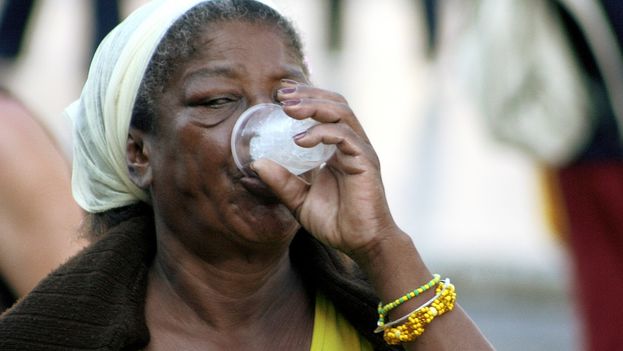

14yMEDIO, Yoani Sanchez, Havana, 22 August 2014 — A woman on national television said that her husband « helps » her with some household chores. To many, the phrase may sound like the highest aspiration of every woman. Another lady asserts that her husband behaves like a « Federated man, » an allusion to the Federation of Cuban Women (FMC), which today is celebrating its 54th anniversary. As for me, on this side of the screen, I feel sorry for them in the face of such meekness. Instead of the urgent demands they should mention, all I hear is this appreciation directed to a power as manly as it is deaf.
It’s not about « helping » to wash a plate or watch the kids, nor tiny illusory gender quotas that hide so much discrimination like a slap. The problem is that economic and political power remains mainly in masculine hands. What percentage of car owners are women? How many acres of land are owned or leased by women. How many Cuban ambassadors on missions abroad wear skirts? Can anyone recite the number of men who request paternity leave to take care of their newborns? How many young men are stopped by the police each day to warn them they can’t walk with a tourist? Who mostly attends the parent meetings at the schools?
Please, don’t try to « put us to sleep » with figures in the style of, « 65 percent of our cadres and 50 percent of our grassroots leaders are women. » The only thing this statistic means is that more responsibility falls on our shoulders, which means neither a high decision-making level nor greater rights. At least such a triumphalist phrase clarifies that there are « grassroots leaders, » because we know that decisions at the highest level are made by men who grew up under the precepts that we women are beautiful ornaments to have at hand… always and as long as we keep our mouths shut.
I feel sorry for the docile and timid feminist movement that exists in my country. Ashamed for those ladies with their ridiculous necklaces and abundant makeup who appear in the official media to tell us that « the Cuban woman has been the greatest ally of the Revolution. » Words spoken at the same moment when a company director is sexually harassing his secretary, when a beaten woman can’t get a restraining order against her abusive husband, when a policeman tells the victim of a sexual assault, « Well, with that skirt you’re wearing… » and the government recruits shock troops for an act of repudiation against the Ladies in White.
Women are the sector of the population that has the most reason to shout their displeasure. Because half a century after the founding of the caricature of an organization that is the Federation of Cuban Women, we are neither more free, nor more powerful, nor even more independent.
Follow this link:
A Caricature of a Cuban Woman








